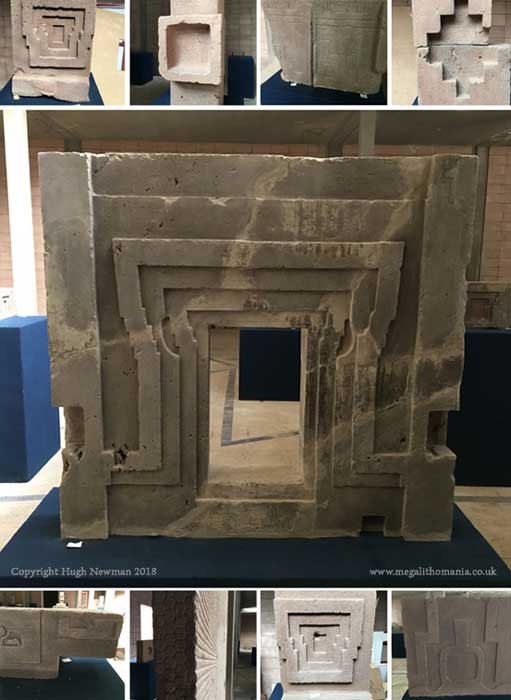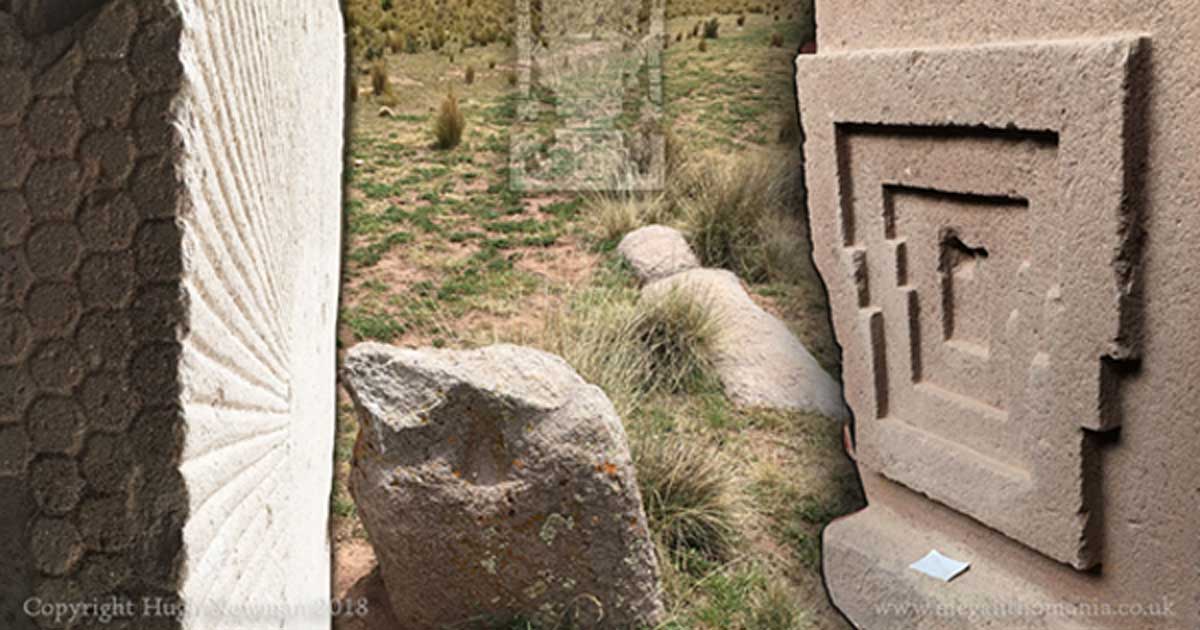New Discoveries at Tiwanaku & Puma Punku: The Lost Statue of Viracocha and Secret Rooms of Hidden Artifacts
In December 2017 myself and fellow megalithic researcher JJ Ainsworth stayed in Tiwanaku for a few days to thoroughly explore the sites of Tiwanaku and Puma Punku looking for any anomalies or things we’d previously missed. I have visited the area ten times over twelve years, and was part of the Ancient Aliens TV show in an episode focussed on the mystery of Puma Punku, but had never had more than one day to explore the complex. This time I had four days.
Destruction at Tiwanaku and Puma Punku
Both sites look like they have been hit with a tidal wave or some other kind of cataclysm. The stones, some weighing up to 80 tons, are scattered around both sites, and often embedded within the mud. Some excavation has been done there, most recently at the Kantatalita Temple at Tiwanaku, and Puma Punku, where they have now revealed that it is a great platform pyramid, similar, but much larger than Tiwanaku’s Akapana Pyramid. The massive pyramid would have once touched the edge of Lake Titicaca. However, the legendary lake is now about 20 miles away.

Puma Punku from the air (Author provided)
Viracocha’s Presence at Tiwanaku
The lake is the origin point of the great bearded god – Viracocha, who was said to have emerged from the waters on to the Island of the Sun, created a team of stone or mud giants and instructed them to build all the megalithic sites and carve statues of their great god along the Path of Viracocha, that included Tiwanaku as its genesis point.
“Punctuating the city center were dozens of stone sculptures carved to mimic human and human-animal forms and the Inca considered these remnant genera of giants from a prior world of proto-human giants who had been turned to stone.”
Janusek, John, 2017
There are many humanoid statues that are thought to represent Viracocha in numerous forms found at both Tiwanaku and Puma Punku. These are on display at the sites as well as various museums, including the ‘Tiwanaku Museum’ in La Paz. These have always fascinated me, as they show abstract form, with what looks like geometric ‘fish-scales’, elaborate belts, and headdresses that resemble those found at the Toltec site of Tula in Mexico, as well as other ‘Tiki’ sites all over the Pacific. Some even resemble statues found at Göbekli Tepe in Turkey and Sulawesi in Indonesia. One of the most interesting ones has a bird head (that was last seen on display in Berlin Museum).

Viracocha depicted in various statues, including a 'birdman' in the Berlin Museum. Notice that it has six toes on its right foot. (Author Provided)
Two are still in-situ in the Kalasasaya Temple, and numerous examples are on display in the on site museum, with the largest one being a staggering 24ft (7.3 m) tall in a special part of the museum. The Bennett Monolith was found in the sunken temple on its back, and has spent some time on display in La Paz, but is now back at the site museum. There are further examples in the sunken temple that are in much rougher form, and do not have the same style or class as the sophisticated Viracocha statues already mentioned.

More Viracocha statues, including the 24ft(7.3m) Bennett Monolith on the right. (Author Provided)
Some of the statues are made of andesite that was quarried from Cerro Khapia across the lake in Peru, and a trail of huge monoliths called ‘lazy stones’ still exist on this ancient route towards the site. We explored and discovered several that mark the path of the stones, some weighing about 40 tons, that we will write about in a forthcoming article. However it seems they chose this specific source because it had the properties they required to create these Viracocha statues, perhaps because they believed the stones were imbued with some kind of energy or even the spirit of some earthly god or goddess.
“Native community members tell endless stories of having witnessed them walking around at night, sometimes in the distance, sometimes approaching fleshy humans to ask for some help, or to follow them on some dangerous venture.”
Janusek, John, 2017
The New Pyramid and an Unrecorded Viracocha
During my exploration of the eastern part of Tiwanaku called the Kantatalita Temple - a raised area that has been recently excavated and thought to possibly be a low pyramid - I noticed some greyish andesite stones behind the fence, in the distance, at the base of this low hill. I thought nothing of it, but when I left the site, I needed a cold drink as it was a swelteringly hot day, so I exited through the northern gate and walked east along the road towards a restaurant to get my drink. After quenching my thirst I took a right turn to take a quick look at the greyish white blocks I had previously spotted.

Kantatalita Temple with huge precision carved stones. (Author Provided)
I was astonished to find an unrecorded Viracocha statue half-buried, facing upwards in the ground that was broken in two pieces. It was badly weathered but was clearly one of these humanoid statues, and the base was still embedded in the ground, suggesting this was its original location. Its precise position may be relevant because it is exactly 1000 feet (305 meters) directly east of the Ponce Monolith at the centre of the square enclosure in the Kalasasaya Temple and precisely 750 feet (229 meters) from the sandstone statues in the Sunken Temple. It might have faced towards the west, looking back directly across the site, through the megalithic doorway and into the eyes of his andesite brother, the Ponce Monolith. However, its current orientation seems to point towards the Akapana Pyramid to the southwest, so it is still unclear if this has any geodetic significance.

The author at the newly discovered Viracocha statue. (Author Provided)
Having looked through all the archaeological records and papers, I could find no mention of this particular statue. It looks like it may well have been buried under mud and long grass for potentially hundreds, or even thousands of years, but the landowner had clearly cut the overgrowth back and recently revealed this new discovery.
I explored the entire area right up to the fence and further east and south of the main site, I found several largish stones, hundreds of pieces of pottery and landscape shaping suggesting a fairly large rectangular area that, because it is outside the perimeter of the Tiwanaku archaeological area, has not been excavated. The dimensions were difficult to calculate as it is still partly buried and may be damaged in other ways. It currently measures 108 inches (9 feet, 2.75 m) tall (30 inch (76cm) base and 78 inch (1.98 m) main statue). See the video above for a full analysis.
More Hidden Statues
On the same day, I pondered the discovery and walked back to the on-site museum, and noticed some huge statues in a shaded, out-of-bounds room. The entrance was blocked by a corrugated iron sheet, but I slipped behind it and managed to get through and take photos of the incredible and unusual statues. These main ones were found at a site called Pokotia, which is about 7 miles (11 km) southeast of Tiwanaku. I had seen old photos of these sophisticated kneeling statues, but this was the first time I got up close to inspect them and managed to get detailed photographs. Similar statues guard the church in the town square.
“The two statues sometimes referred to as Peter and Paul guard the entrance to the town of Tiahuanaco’s church, but according to (Arthur) Posnansky, they originally come from Pokotia.” (Protzen, Jean-Pierre)

Figure 6 - Kneeling statues from Pokotia, seven miles to the southeast of Tiwanaku.
Pokotia is an important site. A further statue was discovered there that is much smaller, but has huge implications due to it having Sumerian script potentially carved on it. This has caused a sensation because the Fuente Magna Bowl, found close to Lake Titicaca had similar text, that some researchers believe to be Sumerian and proto-Sumerian. This had led to some wild speculations about the connection between the Middle East and South America in the distant past, that we will explore in more detail in a later article.
A Hidden Collection
This epic day of discovery did not end there. I found yet another secret room in the on-site museum that has always been locked, but building works were going on that day, so the entrance was unguarded and I sneaked in and closed the door behind me and photographed everything that was in there. Over 30 stone artifacts and statues were in this hidden room. I have never seen any of these particular pieces in any book, website or videos and all my researcher friends knew nothing about them either. Below is a montage of some of the pieces, but please look at the video where all of them are shown in detail.
- Was Bolivia-Peru the Sunset Land of the Sumerians?
- Megalithic Origins: Göbekli Tepe and Ancient Peru - The Same Architects?

Tiwanaku and Puma Punku are still revealing their secrets. It is known that tunnels have been found inside the Akapana Pyramid, elongated skulls and strange metal alloys have been unearthed, and strange, very sophisticated stone pieces are still being uncovered at the sites. A majority of the complex has yet to be excavated and with discoveries like this being made in the current era, it seems that the secrets of Viracocha and his magnificent temples are still being brought to light.
By Hugh Newman
Megalithomania are running a tour to Peru and Bolivia in November 2018 so please consider joining Hugh Newman and JJ Ainsworth to hopefully get access to these rooms and the newly discovered Viracocha statue. Full details at www.megalithomania.co.uk/peru2018.html

References
Janusek, John, Living Stone Beings from Tiwanaku, Bolivia, in Europe. 2017
Available at: https://my.vanderbilt.edu/universityfundingprograms/2017/11/living-stone-beings-from-tiwanaku-bolivia-in-europe/
Protzen, Jean-Pierre; Nair, Stella. Stones of Tiahuanaco: A Study of Architecture and Construction (Monograph Book 75), Cotsen Institute of Archaeology Press.


















Comments
I was struck by the shapes shown on what could be windows, possibly doors on the flat sone pieces. Tho’ I’ve seen many videos on Puma Punca & much elaboration has been made on the various pieces, I hadn’t seen these flat pieces with look like receding sized doorways (gates?) as close before. I’ve seen various shapes used to depict the subjects of Infinity-Space-travel direction indicators & the like. What came to me was the large, flat piece that had differently shaped ‘portals’, 4, I believe, & open to the other side ( not a closed ended piece). What I saw, was a meaning to depict a feeling of Infinity; a ‘beyond’ if you will. Perhaps there’s a double meaning; “ We came from there ( into the portal ), and we go back,(thru these ‘portals), from here”. Symbolicallly, of course. I’ve seen ‘blank' doors, or portals to the other world, or afterlife as shown in tombs & some monuments, & some ancient cult localtions, but those places, & their purposes are fairly well known. I enjoyed watching this video & will look fwd to more news as it’s revealed. Thanks you! MMc